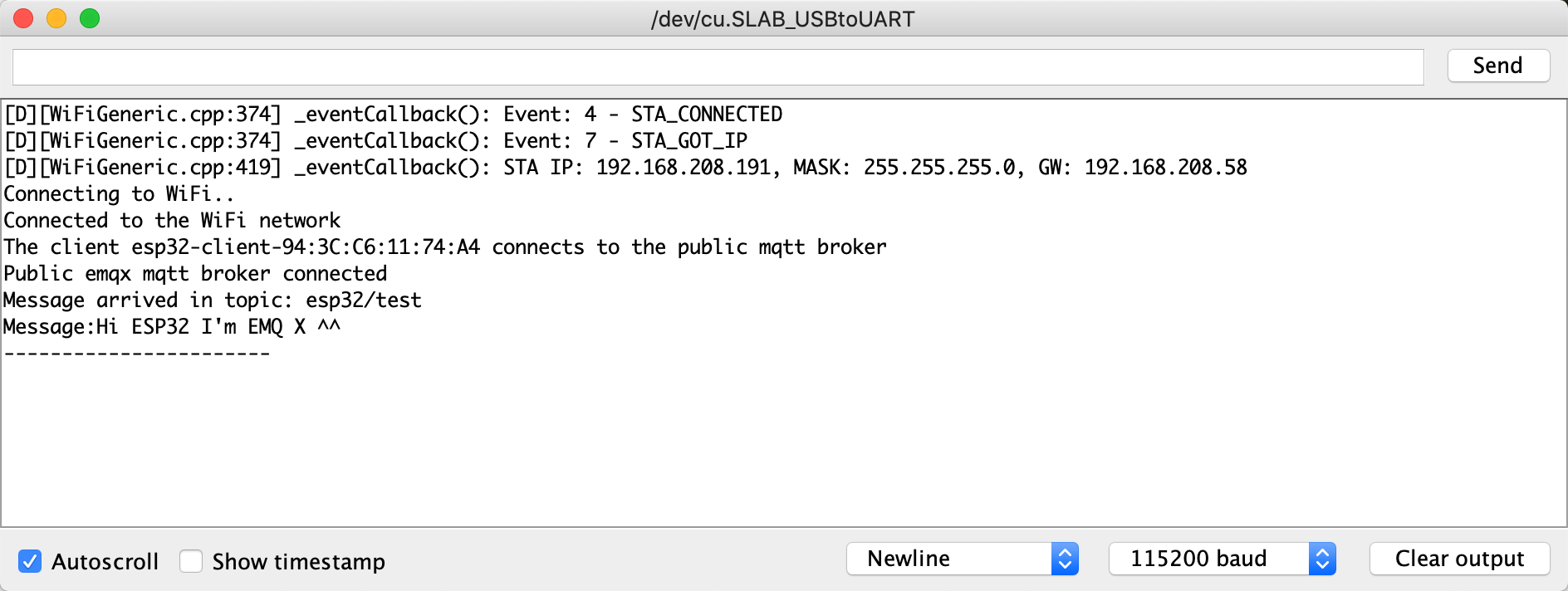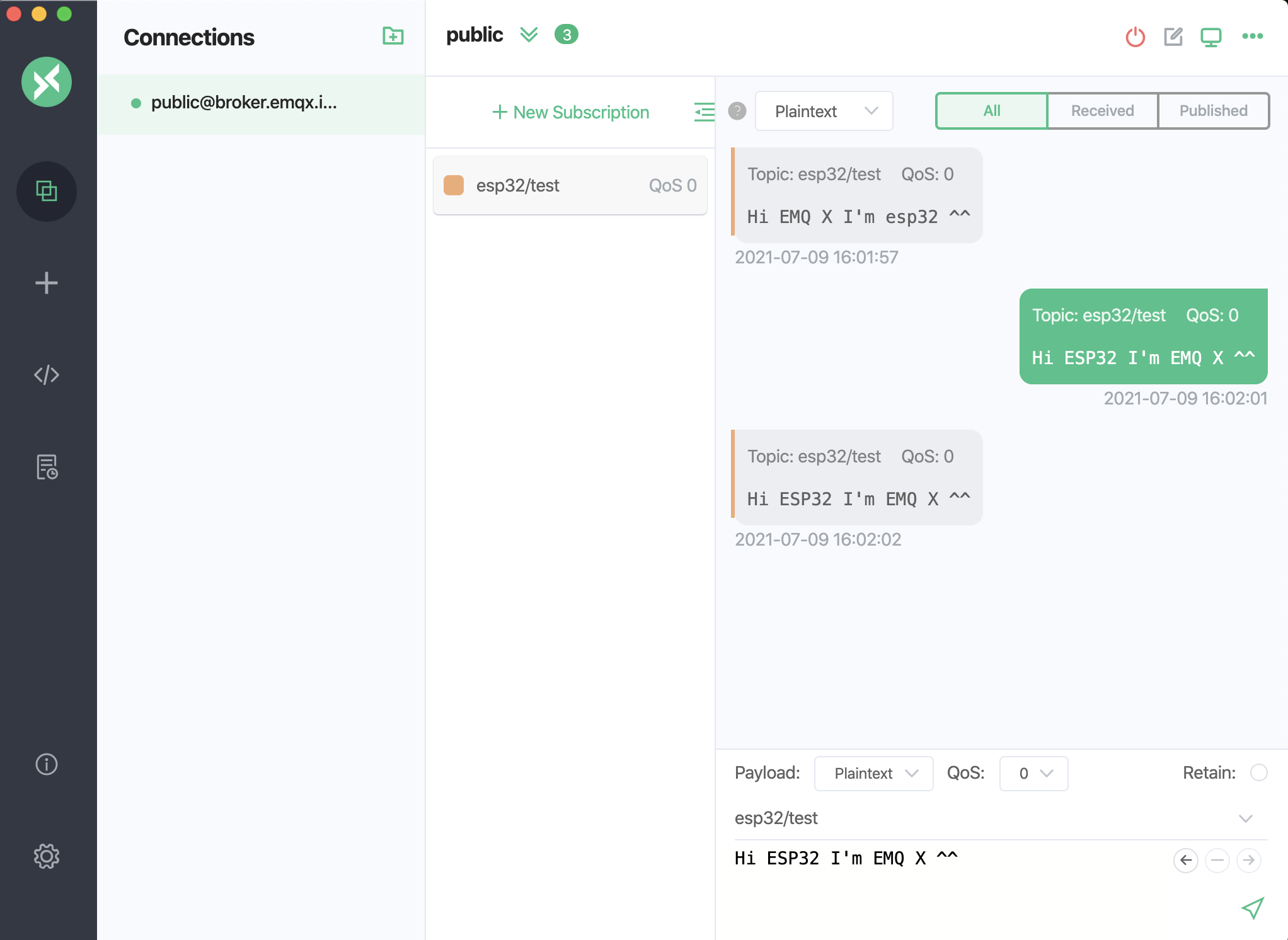Connect with ESP32
This article mainly introduces how to use PubSubClient in the ESP32 project, including implementing the connection, subscription, messaging, and other functions between the client and MQTT broker.
As an upgraded version of ESP8266, ESP32 is an ideal choice for IoT projects. In addition to the Wi-Fi module, this module also includes a Bluetooth 4.0 module. The dual-core CPU operates at a frequency of 80 to 240 MHz. It contains two Wi-Fi and Bluetooth modules and various input and output pins.
This page demonstrates how to connect an ESP32 client to MQTT broker via the TCP port and TLS/SSL port respectively. For Serverless deployments, see the demonstration on TLS/SSL port connection. Settings for connections over TCP port are different from those for connections over TLS/SSL port, but the code used in the publishing and subscribing functions is the same.
Prerequisites
Before the connection, you need to get the broker and client ready. Ensure you have completed the following prerequisites:
- Deploy MQTT Broker
- Prepare Arduino IDE
Deploy MQTT Broker
To connect your application to the EMQX Cloud, you need to create and configure a deployment.
Serverless Deployment
Create a Serverless deployment in the EMQX Cloud Console.
Once the deployment is created and running, go to the deployment Overview page to find the MQTT connection information, including:
Broker address
Port number (only TLS ports are supported in Serverless)
Serverless deployments require TLS connections. Make sure to download the CA certificate from the Overview page and use port
8883for TLS.Configure the default authentication (username/password) under Access Control -> Client Authentication in the deployment.
For more details, refer to the Serverless Port Guide.
Dedicated Flex or BYOC Deployment
- You can create a Dedicated Flex or BYOC deployment in the EMQX Cloud Console.
- After creation, go to the deployment Overview page to retrieve MQTT connection information, including:
- Broker address
- TCP and TLS port numbers for MQTT and WebSocket (Both TCP and TLS connections are supported).
- Configure the default authentication (username/password) under Access Control -> Client Authentication in the deployment.
For detailed port configurations, see the Dedicated & BYOC Port Guide.
Arduino IDE
This demonstration uses the Arduino IDE as the code editor and uploader. The open-source Arduino Software (IDE) makes it easy to write code and upload it to the board. This software can be used with any Arduino board.
Installation Dependencies
In Arduino IDE, complete the following installations:
- Install ESP32 development board. Click Tools -> Development Board -> Development Board Management. Search ESP32 and click Install.
- Install PubSub client. Click Project -> Load library -> Library manager.... Search PubSubClient and Install PubSubClient by Nick O’Leary.
Connect over TCP Port
This section describes how to connect an ESP32 client to MQTT broker over TCP port in Arduino IDE.
- Import the WiFi and PubSubClient libraries.
#include <WiFi.h>
#include <PubSubClient.h>- Set the Wi-Fi name and password, as well as the MQTT server connection address and port, and set the topic to
esp32/test.
The sample code will use a public MQTT server to connect, and the public MQTT server does not require a username and password. If you create a deployment, please refer to Default Authentication to set username and password.
// WiFi Credentials
const char *ssid = "WIFI_SSID"; // Replace with your WiFi name
const char *password = "WIFI_PASSWORD"; // Replace with your WiFi password
// MQTT Broker Settings
const char *mqtt_broker = "broker.emqx.io";
const char *mqtt_topic = "emqx/esp32";
const char *mqtt_username = "emqx";
const char *mqtt_password = "public";
const int mqtt_port = 1883;- Open a serial connection to output the results of the program and connect to the Wi-Fi network.
void setup() {
Serial.begin(115200);
connectToWiFi();
mqtt_client.setServer(mqtt_broker, mqtt_port);
mqtt_client.setKeepAlive(60);
mqtt_client.setCallback(mqttCallback); // Corrected callback function name
connectToMQTT();
}
void connectToWiFi() {
WiFi.begin(ssid, password);
Serial.print("Connecting to WiFi");
while (WiFi.status() != WL_CONNECTED) {
delay(500);
Serial.print(".");
}
Serial.println("\nConnected to WiFi");
}- Use PubSubClient to connect to the public MQTT broker.
void connectToMQTT() {
while (!mqtt_client.connected()) {
String client_id = "esp32-client-" + String(WiFi.macAddress());
Serial.printf("Connecting to MQTT Broker as %s.....\n", client_id.c_str());
if (mqtt_client.connect(client_id.c_str(), mqtt_username, mqtt_password)) {
Serial.println("Connected to MQTT broker");
mqtt_client.subscribe(mqtt_topic);
mqtt_client.publish(mqtt_topic, "Hi EMQX I'm ESP32 ^^"); // Publish message upon successful connection
} else {
Serial.print("Failed, rc=");
Serial.print(mqtt_client.state());
Serial.println(" try again in 5 seconds");
delay(5000);
}
}
}- After the MQTT server is successfully connected, ESP32 will publish messages on topic
esp32/testto the MQTT server and subscribe to messages on topicesp32/test.
// publish and subscribe
mqtt_client.subscribe(mqtt_topic);
mqtt_client.publish(mqtt_topic, "Hi EMQX I'm ESP32 ^^"); // Publish message upon successful connection- Set the callback function to print the topic name to the serial port and print the message received from the
esp32/testtopic.
void mqttCallback(char *mqtt_topic, byte *payload, unsigned int length) {
Serial.print("Message received on mqtt_topic: ");
Serial.println(mqtt_topic);
Serial.print("Message: ");
for (unsigned int i = 0; i < length; i++) {
Serial.print((char) payload[i]);
}
Serial.println("\n-----------------------");
}The complete code is displayed as follows:
#include <WiFi.h>
#include <PubSubClient.h>
// WiFi Credentials
const char *ssid = "WIFI_SSID"; // Replace with your WiFi name
const char *password = "WIFI_PASSWORD"; // Replace with your WiFi password
// MQTT Broker Settings
const char *mqtt_broker = "broker.emqx.io";
const char *mqtt_topic = "emqx/esp32";
const char *mqtt_username = "emqx";
const char *mqtt_password = "public";
const int mqtt_port = 1883;
WiFiClient espClient;
PubSubClient mqtt_client(espClient);
// Function Declarations
void connectToWiFi();
void connectToMQTT();
void mqttCallback(char *mqtt_topic, byte *payload, unsigned int length);
void setup() {
Serial.begin(115200);
connectToWiFi();
mqtt_client.setServer(mqtt_broker, mqtt_port);
mqtt_client.setKeepAlive(60);
mqtt_client.setCallback(mqttCallback); // Corrected callback function name
connectToMQTT();
}
void connectToWiFi() {
WiFi.begin(ssid, password);
Serial.print("Connecting to WiFi");
while (WiFi.status() != WL_CONNECTED) {
delay(500);
Serial.print(".");
}
Serial.println("\nConnected to WiFi");
}
void connectToMQTT() {
while (!mqtt_client.connected()) {
String client_id = "esp32-client-" + String(WiFi.macAddress());
Serial.printf("Connecting to MQTT Broker as %s.....\n", client_id.c_str());
if (mqtt_client.connect(client_id.c_str(), mqtt_username, mqtt_password)) {
Serial.println("Connected to MQTT broker");
mqtt_client.subscribe(mqtt_topic);
mqtt_client.publish(mqtt_topic, "Hi EMQX I'm ESP32 ^^"); // Publish message upon successful connection
} else {
Serial.print("Failed, rc=");
Serial.print(mqtt_client.state());
Serial.println(" try again in 5 seconds");
delay(5000);
}
}
}
void mqttCallback(char *mqtt_topic, byte *payload, unsigned int length) {
Serial.print("Message received on mqtt_topic: ");
Serial.println(mqtt_topic);
Serial.print("Message: ");
for (unsigned int i = 0; i < length; i++) {
Serial.print((char) payload[i]);
}
Serial.println("\n-----------------------");
}
void loop() {
if (!mqtt_client.connected()) {
connectToMQTT();
}
mqtt_client.loop();
}Connect over TLS/SSL Port
This section describes how to connect an ESP32 client to MQTT broker over TLS/SSL port in Arduino IDE. Settings for connections over TLS/SSL ports are different from those for connections over TCP port, but the code is the same in the publishing and subscribing functions.
- Import libraries ESP32WiFi and PubSubClient.
#include <WiFi.h>
#include <PubSubClient.h>
#include <WiFiClientSecure.h>- Set Wi-Fi name and password, and connection address and port.
The sample code will use a public MQTT server to connect, and the public MQTT server does not require a username and password. If you create a deployment, please refer to Default Authentication to set username and password.
// WiFi credentials
const char *ssid = "WIFI_SSID"; // Replace with your WiFi name
const char *password = "WIFI_PASSWORD"; // Replace with your WiFi password
// MQTT Broker settings
const char *mqtt_broker = "broker.emqx.io";
const char *mqtt_topic = "emqx/esp32";
const char *mqtt_username = "emqx";
const char *mqtt_password = "public";
const int mqtt_port = 8883;Set server-side certificate.
If you are using a public MQTT broker, download CA certificate here for TLS/SSL port connection with Serverless deployment. If you are using Dedicated Flex deployment, use your own server-side certificate.
// Root CA Certificate
// Load DigiCert Global Root G2, which is used by EMQX Public Broker: broker.emqx.io
const char *ca_cert = R"EOF(
-----BEGIN CERTIFICATE-----
MIIDjjCCAnagAwIBAgIQAzrx5qcRqaC7KGSxHQn65TANBgkqhkiG9w0BAQsFADBh
MQswCQYDVQQGEwJVUzEVMBMGA1UEChMMRGlnaUNlcnQgSW5jMRkwFwYDVQQLExB3
d3cuZGlnaWNlcnQuY29tMSAwHgYDVQQDExdEaWdpQ2VydCBHbG9iYWwgUm9vdCBH
MjAeFw0xMzA4MDExMjAwMDBaFw0zODAxMTUxMjAwMDBaMGExCzAJBgNVBAYTAlVT
MRUwEwYDVQQKEwxEaWdpQ2VydCBJbmMxGTAXBgNVBAsTEHd3dy5kaWdpY2VydC5j
b20xIDAeBgNVBAMTF0RpZ2lDZXJ0IEdsb2JhbCBSb290IEcyMIIBIjANBgkqhkiG
9w0BAQEFAAOCAQ8AMIIBCgKCAQEAuzfNNNx7a8myaJCtSnX/RrohCgiN9RlUyfuI
2/Ou8jqJkTx65qsGGmvPrC3oXgkkRLpimn7Wo6h+4FR1IAWsULecYxpsMNzaHxmx
1x7e/dfgy5SDN67sH0NO3Xss0r0upS/kqbitOtSZpLYl6ZtrAGCSYP9PIUkY92eQ
q2EGnI/yuum06ZIya7XzV+hdG82MHauVBJVJ8zUtluNJbd134/tJS7SsVQepj5Wz
tCO7TG1F8PapspUwtP1MVYwnSlcUfIKdzXOS0xZKBgyMUNGPHgm+F6HmIcr9g+UQ
vIOlCsRnKPZzFBQ9RnbDhxSJITRNrw9FDKZJobq7nMWxM4MphQIDAQABo0IwQDAP
BgNVHRMBAf8EBTADAQH/MA4GA1UdDwEB/wQEAwIBhjAdBgNVHQ4EFgQUTiJUIBiV
5uNu5g/6+rkS7QYXjzkwDQYJKoZIhvcNAQELBQADggEBAGBnKJRvDkhj6zHd6mcY
1Yl9PMWLSn/pvtsrF9+wX3N3KjITOYFnQoQj8kVnNeyIv/iPsGEMNKSuIEyExtv4
NeF22d+mQrvHRAiGfzZ0JFrabA0UWTW98kndth/Jsw1HKj2ZL7tcu7XUIOGZX1NG
Fdtom/DzMNU+MeKNhJ7jitralj41E6Vf8PlwUHBHQRFXGU7Aj64GxJUTFy8bJZ91
8rGOmaFvE7FBcf6IKshPECBV1/MUReXgRPTqh5Uykw7+U0b6LJ3/iyK5S9kJRaTe
pLiaWN0bfVKfjllDiIGknibVb63dDcY3fe0Dkhvld1927jyNxF1WW6LZZm6zNTfl
MrY=
-----END CERTIFICATE-----
)EOF";
// Load DigiCert Global Root CA ca_cert, which is used by EMQX Serverless Deployment
/*
const char* ca_cert = R"EOF(
-----BEGIN CERTIFICATE-----
MIIDrzCCApegAwIBAgIQCDvgVpBCRrGhdWrJWZHHSjANBgkqhkiG9w0BAQUFADBh
MQswCQYDVQQGEwJVUzEVMBMGA1UEChMMRGlnaUNlcnQgSW5jMRkwFwYDVQQLExB3
d3cuZGlnaWNlcnQuY29tMSAwHgYDVQQDExdEaWdpQ2VydCBHbG9iYWwgUm9vdCBD
QTAeFw0wNjExMTAwMDAwMDBaFw0zMTExMTAwMDAwMDBaMGExCzAJBgNVBAYTAlVT
MRUwEwYDVQQKEwxEaWdpQ2VydCBJbmMxGTAXBgNVBAsTEHd3dy5kaWdpY2VydC5j
b20xIDAeBgNVBAMTF0RpZ2lDZXJ0IEdsb2JhbCBSb290IENBMIIBIjANBgkqhkiG
9w0BAQEFAAOCAQ8AMIIBCgKCAQEA4jvhEXLeqKTTo1eqUKKPC3eQyaKl7hLOllsB
CSDMAZOnTjC3U/dDxGkAV53ijSLdhwZAAIEJzs4bg7/fzTtxRuLWZscFs3YnFo97
nh6Vfe63SKMI2tavegw5BmV/Sl0fvBf4q77uKNd0f3p4mVmFaG5cIzJLv07A6Fpt
43C/dxC//AH2hdmoRBBYMql1GNXRor5H4idq9Joz+EkIYIvUX7Q6hL+hqkpMfT7P
T19sdl6gSzeRntwi5m3OFBqOasv+zbMUZBfHWymeMr/y7vrTC0LUq7dBMtoM1O/4
gdW7jVg/tRvoSSiicNoxBN33shbyTApOB6jtSj1etX+jkMOvJwIDAQABo2MwYTAO
BgNVHQ8BAf8EBAMCAYYwDwYDVR0TAQH/BAUwAwEB/zAdBgNVHQ4EFgQUA95QNVbR
TLtm8KPiGxvDl7I90VUwHwYDVR0jBBgwFoAUA95QNVbRTLtm8KPiGxvDl7I90VUw
DQYJKoZIhvcNAQEFBQADggEBAMucN6pIExIK+t1EnE9SsPTfrgT1eXkIoyQY/Esr
hMAtudXH/vTBH1jLuG2cenTnmCmrEbXjcKChzUyImZOMkXDiqw8cvpOp/2PV5Adg
06O/nVsJ8dWO41P0jmP6P6fbtGbfYmbW0W5BjfIttep3Sp+dWOIrWcBAI+0tKIJF
PnlUkiaY4IBIqDfv8NZ5YBberOgOzW6sRBc4L0na4UU+Krk2U886UAb3LujEV0ls
YSEY1QSteDwsOoBrp+uvFRTp2InBuThs4pFsiv9kuXclVzDAGySj4dzp30d8tbQk
CAUw7C29C79Fv1C5qfPrmAESrciIxpg0X40KPMbp1ZWVbd4=
-----END CERTIFICATE-----
*/- Open a serial connection to output of the result of the program and connect to the Wi-Fi network.
void setup() {
Serial.begin(115200);
connectToWiFi();
// Set Root CA certificate
esp_client.setCACert(ca_cert);
mqtt_client.setServer(mqtt_broker, mqtt_port);
mqtt_client.setKeepAlive(60);
mqtt_client.setCallback(mqttCallback);
connectToMQTT();
}
void connectToWiFi() {
WiFi.begin(ssid, password);
Serial.print("Connecting to WiFi");
while (WiFi.status() != WL_CONNECTED) {
delay(500);
Serial.print(".");
}
Serial.println("\nConnected to WiFi");
}- Set certificate, and MQTT broker, write callback function, and print connection information on the serial monitor at the same time.
void connectToMQTT() {
while (!mqtt_client.connected()) {
String client_id = "esp32-client-" + String(WiFi.macAddress());
Serial.printf("Connecting to MQTT Broker as %s...\n", client_id.c_str());
if (mqtt_client.connect(client_id.c_str(), mqtt_username, mqtt_password)) {
Serial.println("Connected to MQTT broker");
mqtt_client.subscribe(mqtt_topic);
mqtt_client.publish(mqtt_topic, "Hi EMQX I'm ESP32 ^^"); // Publish message upon connection
} else {
Serial.print("Failed to connect to MQTT broker, rc=");
Serial.print(mqtt_client.state());
Serial.println(" Retrying in 5 seconds.");
delay(5000);
}
}
}- After successfully connecting to the MQTT broker, ESP32 will publish messages and subscribe to the MQTT broker.
// publish and subscribe
mqtt_client.subscribe(mqtt_topic);
mqtt_client.publish(mqtt_topic, "Hi EMQX I'm ESP32 ^^"); // Publish message upon connection- Print the topic name to the serial port and then print every byte of received messages.
void callback(char *topic, byte *payload, unsigned int length) {
Serial.print("Message arrived in topic: ");
Serial.println(topic);
Serial.print("Message:");
for (int i = 0; i < length; i++) {
Serial.print((char) payload[i]);
}
Serial.println();
Serial.println("-----------------------");
}- Reconnect function
void mqttCallback(char *topic, byte *payload, unsigned int length) {
Serial.print("Message received on topic: ");
Serial.println(topic);
Serial.print("Message: ");
for (unsigned int i = 0; i < length; i++) {
Serial.print((char) payload[i]);
}
Serial.println("\n-----------------------");
}The complete code is displayed as follows:
#include <WiFi.h>
#include <PubSubClient.h>
#include <WiFiClientSecure.h>
// WiFi credentials
const char *ssid = "WIFI_SSID"; // Replace with your WiFi name
const char *password = "WIFI_PASSWORD"; // Replace with your WiFi password
// MQTT Broker settings
const char *mqtt_broker = "broker.emqx.io";
const char *mqtt_topic = "emqx/esp32";
const char *mqtt_username = "emqx";
const char *mqtt_password = "public";
const int mqtt_port = 8883;
// WiFi and MQTT client initialization
WiFiClientSecure esp_client;
PubSubClient mqtt_client(esp_client);
// Root CA Certificate
// Load DigiCert Global Root G2, which is used by EMQX Public Broker: broker.emqx.io
const char *ca_cert = R"EOF(
-----BEGIN CERTIFICATE-----
MIIDjjCCAnagAwIBAgIQAzrx5qcRqaC7KGSxHQn65TANBgkqhkiG9w0BAQsFADBh
MQswCQYDVQQGEwJVUzEVMBMGA1UEChMMRGlnaUNlcnQgSW5jMRkwFwYDVQQLExB3
d3cuZGlnaWNlcnQuY29tMSAwHgYDVQQDExdEaWdpQ2VydCBHbG9iYWwgUm9vdCBH
MjAeFw0xMzA4MDExMjAwMDBaFw0zODAxMTUxMjAwMDBaMGExCzAJBgNVBAYTAlVT
MRUwEwYDVQQKEwxEaWdpQ2VydCBJbmMxGTAXBgNVBAsTEHd3dy5kaWdpY2VydC5j
b20xIDAeBgNVBAMTF0RpZ2lDZXJ0IEdsb2JhbCBSb290IEcyMIIBIjANBgkqhkiG
9w0BAQEFAAOCAQ8AMIIBCgKCAQEAuzfNNNx7a8myaJCtSnX/RrohCgiN9RlUyfuI
2/Ou8jqJkTx65qsGGmvPrC3oXgkkRLpimn7Wo6h+4FR1IAWsULecYxpsMNzaHxmx
1x7e/dfgy5SDN67sH0NO3Xss0r0upS/kqbitOtSZpLYl6ZtrAGCSYP9PIUkY92eQ
q2EGnI/yuum06ZIya7XzV+hdG82MHauVBJVJ8zUtluNJbd134/tJS7SsVQepj5Wz
tCO7TG1F8PapspUwtP1MVYwnSlcUfIKdzXOS0xZKBgyMUNGPHgm+F6HmIcr9g+UQ
vIOlCsRnKPZzFBQ9RnbDhxSJITRNrw9FDKZJobq7nMWxM4MphQIDAQABo0IwQDAP
BgNVHRMBAf8EBTADAQH/MA4GA1UdDwEB/wQEAwIBhjAdBgNVHQ4EFgQUTiJUIBiV
5uNu5g/6+rkS7QYXjzkwDQYJKoZIhvcNAQELBQADggEBAGBnKJRvDkhj6zHd6mcY
1Yl9PMWLSn/pvtsrF9+wX3N3KjITOYFnQoQj8kVnNeyIv/iPsGEMNKSuIEyExtv4
NeF22d+mQrvHRAiGfzZ0JFrabA0UWTW98kndth/Jsw1HKj2ZL7tcu7XUIOGZX1NG
Fdtom/DzMNU+MeKNhJ7jitralj41E6Vf8PlwUHBHQRFXGU7Aj64GxJUTFy8bJZ91
8rGOmaFvE7FBcf6IKshPECBV1/MUReXgRPTqh5Uykw7+U0b6LJ3/iyK5S9kJRaTe
pLiaWN0bfVKfjllDiIGknibVb63dDcY3fe0Dkhvld1927jyNxF1WW6LZZm6zNTfl
MrY=
-----END CERTIFICATE-----
)EOF";
// Load DigiCert Global Root CA ca_cert, which is used by EMQX Serverless Deployment
/*
const char* ca_cert = R"EOF(
-----BEGIN CERTIFICATE-----
MIIDrzCCApegAwIBAgIQCDvgVpBCRrGhdWrJWZHHSjANBgkqhkiG9w0BAQUFADBh
MQswCQYDVQQGEwJVUzEVMBMGA1UEChMMRGlnaUNlcnQgSW5jMRkwFwYDVQQLExB3
d3cuZGlnaWNlcnQuY29tMSAwHgYDVQQDExdEaWdpQ2VydCBHbG9iYWwgUm9vdCBD
QTAeFw0wNjExMTAwMDAwMDBaFw0zMTExMTAwMDAwMDBaMGExCzAJBgNVBAYTAlVT
MRUwEwYDVQQKEwxEaWdpQ2VydCBJbmMxGTAXBgNVBAsTEHd3dy5kaWdpY2VydC5j
b20xIDAeBgNVBAMTF0RpZ2lDZXJ0IEdsb2JhbCBSb290IENBMIIBIjANBgkqhkiG
9w0BAQEFAAOCAQ8AMIIBCgKCAQEA4jvhEXLeqKTTo1eqUKKPC3eQyaKl7hLOllsB
CSDMAZOnTjC3U/dDxGkAV53ijSLdhwZAAIEJzs4bg7/fzTtxRuLWZscFs3YnFo97
nh6Vfe63SKMI2tavegw5BmV/Sl0fvBf4q77uKNd0f3p4mVmFaG5cIzJLv07A6Fpt
43C/dxC//AH2hdmoRBBYMql1GNXRor5H4idq9Joz+EkIYIvUX7Q6hL+hqkpMfT7P
T19sdl6gSzeRntwi5m3OFBqOasv+zbMUZBfHWymeMr/y7vrTC0LUq7dBMtoM1O/4
gdW7jVg/tRvoSSiicNoxBN33shbyTApOB6jtSj1etX+jkMOvJwIDAQABo2MwYTAO
BgNVHQ8BAf8EBAMCAYYwDwYDVR0TAQH/BAUwAwEB/zAdBgNVHQ4EFgQUA95QNVbR
TLtm8KPiGxvDl7I90VUwHwYDVR0jBBgwFoAUA95QNVbRTLtm8KPiGxvDl7I90VUw
DQYJKoZIhvcNAQEFBQADggEBAMucN6pIExIK+t1EnE9SsPTfrgT1eXkIoyQY/Esr
hMAtudXH/vTBH1jLuG2cenTnmCmrEbXjcKChzUyImZOMkXDiqw8cvpOp/2PV5Adg
06O/nVsJ8dWO41P0jmP6P6fbtGbfYmbW0W5BjfIttep3Sp+dWOIrWcBAI+0tKIJF
PnlUkiaY4IBIqDfv8NZ5YBberOgOzW6sRBc4L0na4UU+Krk2U886UAb3LujEV0ls
YSEY1QSteDwsOoBrp+uvFRTp2InBuThs4pFsiv9kuXclVzDAGySj4dzp30d8tbQk
CAUw7C29C79Fv1C5qfPrmAESrciIxpg0X40KPMbp1ZWVbd4=
-----END CERTIFICATE-----
*/
// Function Declarations
void connectToWiFi();
void connectToMQTT();
void mqttCallback(char *topic, byte *payload, unsigned int length);
void setup() {
Serial.begin(115200);
connectToWiFi();
// Set Root CA certificate
esp_client.setCACert(ca_cert);
mqtt_client.setServer(mqtt_broker, mqtt_port);
mqtt_client.setKeepAlive(60);
mqtt_client.setCallback(mqttCallback);
connectToMQTT();
}
void connectToWiFi() {
WiFi.begin(ssid, password);
Serial.print("Connecting to WiFi");
while (WiFi.status() != WL_CONNECTED) {
delay(500);
Serial.print(".");
}
Serial.println("\nConnected to WiFi");
}
void connectToMQTT() {
while (!mqtt_client.connected()) {
String client_id = "esp32-client-" + String(WiFi.macAddress());
Serial.printf("Connecting to MQTT Broker as %s...\n", client_id.c_str());
if (mqtt_client.connect(client_id.c_str(), mqtt_username, mqtt_password)) {
Serial.println("Connected to MQTT broker");
mqtt_client.subscribe(mqtt_topic);
mqtt_client.publish(mqtt_topic, "Hi EMQX I'm ESP32 ^^"); // Publish message upon connection
} else {
Serial.print("Failed to connect to MQTT broker, rc=");
Serial.print(mqtt_client.state());
Serial.println(" Retrying in 5 seconds.");
delay(5000);
}
}
}
void mqttCallback(char *topic, byte *payload, unsigned int length) {
Serial.print("Message received on topic: ");
Serial.println(topic);
Serial.print("Message: ");
for (unsigned int i = 0; i < length; i++) {
Serial.print((char) payload[i]);
}
Serial.println("\n-----------------------");
}
void loop() {
if (!mqtt_client.connected()) {
connectToMQTT();
}
mqtt_client.loop();
}Test Connection
After the ESP32 client has successfully connected to the MQTT broker, you can use the Arduino IDE and MQTTX to test the connection.
- Open the serial monitor, select 115200 baud rate, and check the ESP32 connection status.

- Establish the connection between MQTTX client and MQTT broker, and send messages to ESP32.

More
In summary, we have created an MQTT connection in an ESP32 project, and simulated the connecting, subscribing, sending and receiving messages between the client and MQTT broker. You can download the source code of the example here, and you can also find more demo examples in other languages on GitHub.